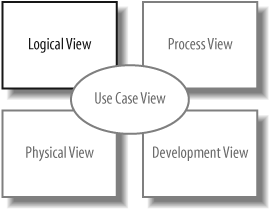Chapter 6. Bringing Your Classes to Life: Object Diagrams
Objects are at the heart of any object-oriented system at runtime. When the system you designed is actually in use, objects make up its parts and bring all of your carefully designed classes to life.
Compared to class diagrams, object diagram notation is very simple. Despite having a fairly limited vocabulary, object diagrams are particularly useful when you want to describe how the objects within the system would work together in a particular scenario. Class diagrams describe how all of the different types of objects within your system interact with each other. They also draw attention to the many ways that the objects will exist and interact within your system at runtime. In addition to class diagrams, object diagrams help you capture the logical view of your model, shown in Figure 6-1.

Object Instances
To draw an object diagram, the first thing you need to add are the actual objects themselves. Object notation is actually very simple if you’re already familiar with class notation; an object is shown with a rectangle, just like a class, but to show that this is an instance of a class rather than the class itself, the title is underlined, as shown in Figure 6-2.
Get Learning UML 2.0 now with the O’Reilly learning platform.
O’Reilly members experience books, live events, courses curated by job role, and more from O’Reilly and nearly 200 top publishers.

